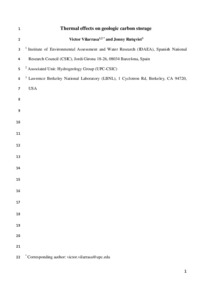Mostra el registre d'ítem simple
Thermal effects on geologic carbon storage
| dc.contributor.author | Vilarrasa Riaño, Víctor |
| dc.contributor.author | Rutqvist, Jonny |
| dc.date.accessioned | 2017-05-05T16:23:50Z |
| dc.date.available | 2018-02-01T01:30:54Z |
| dc.date.issued | 2017-02-01 |
| dc.identifier.citation | Vilarrasa, V., Rutqvist, J. Thermal effects on geologic carbon storage. "Earth-science reviews", 1 Febrer 2017, vol. 165, p. 245-256. |
| dc.identifier.issn | 0012-8252 |
| dc.identifier.uri | http://hdl.handle.net/2117/104137 |
| dc.description | The final publication is available at Springer via http://dx.doi.org/10.1016/j.earscirev.2016.12.011 |
| dc.description.abstract | One of the most promising ways to significantly reduce greenhouse gases emissions, while carbon-free energy sources are developed, is Carbon Capture and Storage (CCS). Non-isothermal effects play a major role in all stages of CCS. In this paper, we review the literature on thermal effects related to CCS, which is receiving an increasing interest as a result of the awareness that the comprehension of non-isothermal processes is crucial for a successful deployment of CCS projects. We start by reviewing CO2 transport, which connects the regions where CO2 is captured with suitable geostorage sites. The optimal conditions for CO2 transport, both onshore (through pipelines) and offshore (through pipelines or ships), are such that CO2 stays in liquid state. To minimize costs, CO2 should ideally be injected at the wellhead in similar pressure and temperature conditions as it is delivered by transport. To optimize the injection conditions, coupled wellbore and reservoir simulators that solve the strongly non-linear problem of CO2 pressure, temperature and density within the wellbore and non-isothermal two-phase flow within the storage formation have been developed. CO2 in its way down the injection well heats up due to compression and friction at a lower rate than the geothermal gradient, and thus, reaches the storage formation at a lower temperature than that of the rock. Inside the storage formation, CO2 injection induces temperature changes due to the advection of the cool injected CO2, the Joule-Thomson cooling effect, endothermic water vaporization and exothermic CO2 dissolution. These thermal effects lead to thermo-hydro-mechanical-chemical coupled processes with non-trivial interpretations. These coupled processes also play a relevant role in “Utilization” options that may provide an added value to the injected CO2, such as Enhanced Oil Recovery (EOR), Enhanced Coal Bed Methane (ECBM) and geothermal energy extraction combined with CO2 storage. If the injected CO2 leaks through faults, the caprock or wellbores, strong cooling will occur due to the expansion of CO2 as pressure decreases with depth. Finally, we conclude by identifying research gaps and challenges of thermal effects related to CCS. |
| dc.format.extent | 12 p. |
| dc.language.iso | eng |
| dc.subject | Àrees temàtiques de la UPC::Enginyeria civil::Geologia |
| dc.subject.lcsh | Carbon dioxide--Storage |
| dc.subject.other | CO2 transport |
| dc.subject.other | Injection schemes |
| dc.subject.other | CO2 storage |
| dc.subject.other | Thermo-hydro-mechanical-chemical couplings |
| dc.subject.other | Induced microseismicity |
| dc.subject.other | Caprock integrity |
| dc.subject.other | Well integrity |
| dc.subject.other | CO2 leakage |
| dc.title | Thermal effects on geologic carbon storage |
| dc.type | Article |
| dc.subject.lemac | Diòxid de carboni -- Emmagatzematge |
| dc.identifier.doi | 10.1016/j.earscirev.2016.12.011 |
| dc.description.peerreviewed | Peer Reviewed |
| dc.relation.publisherversion | http://www.sciencedirect.com/science/article/pii/S0012825216301982 |
| dc.rights.access | Open Access |
| local.identifier.drac | 20096833 |
| dc.description.version | Postprint (author's final draft) |
| dc.relation.projectid | info:eu-repo/grantAgreement/EC/H2020/640979/EU/Maximizing the EU shale gas potential by minimizing its environmental footprint/ShaleXenvironmenT |
| local.citation.author | Vilarrasa, V.; Rutqvist, J. |
| local.citation.publicationName | Earth-science reviews |
| local.citation.volume | 165 |
| local.citation.startingPage | 245 |
| local.citation.endingPage | 256 |


